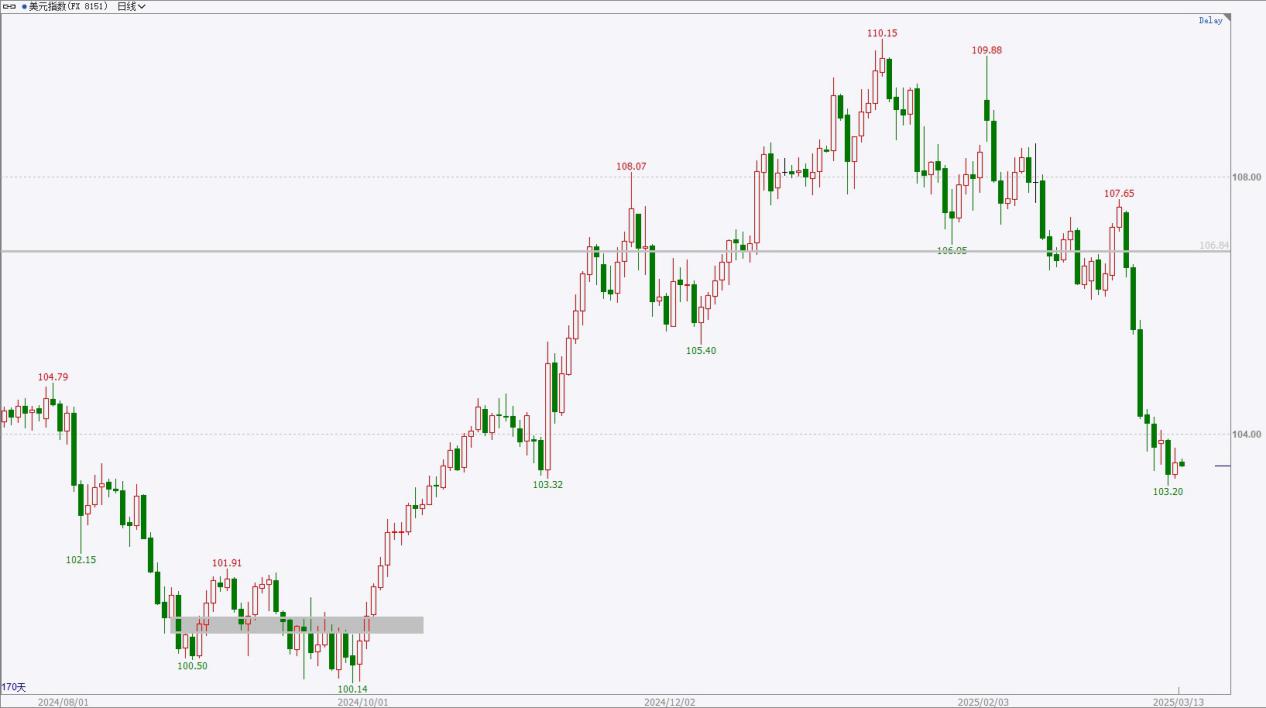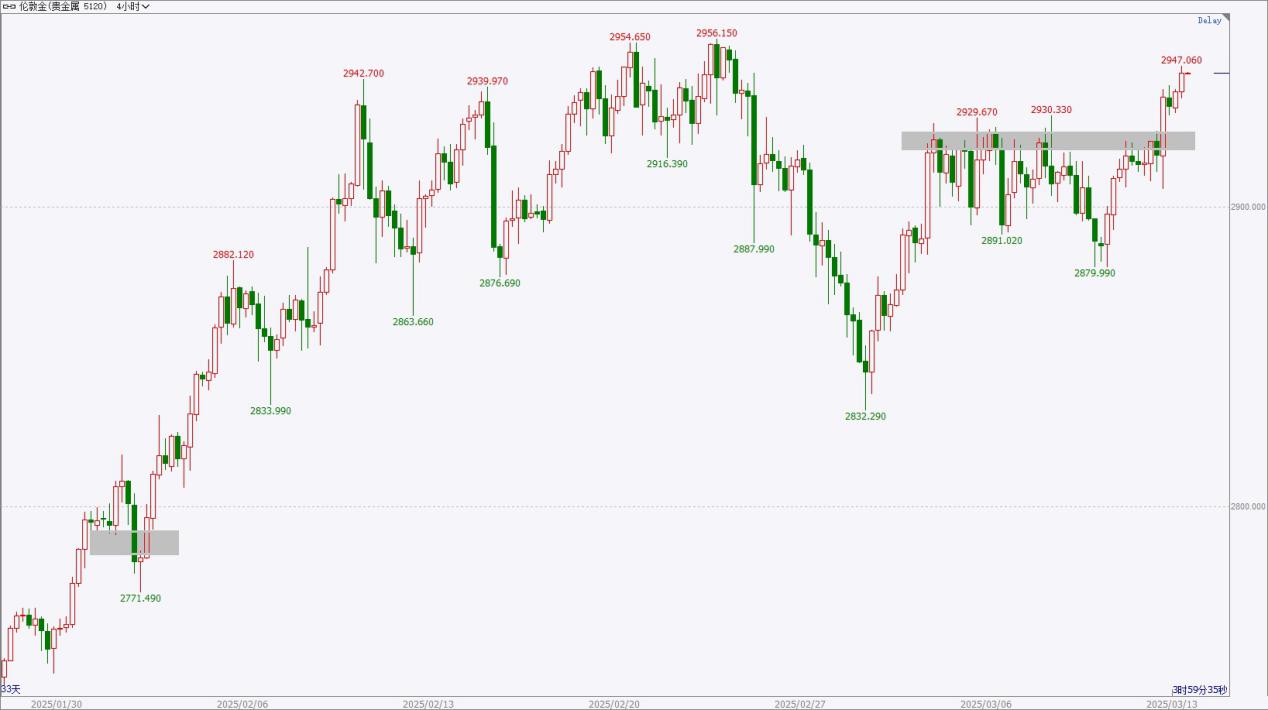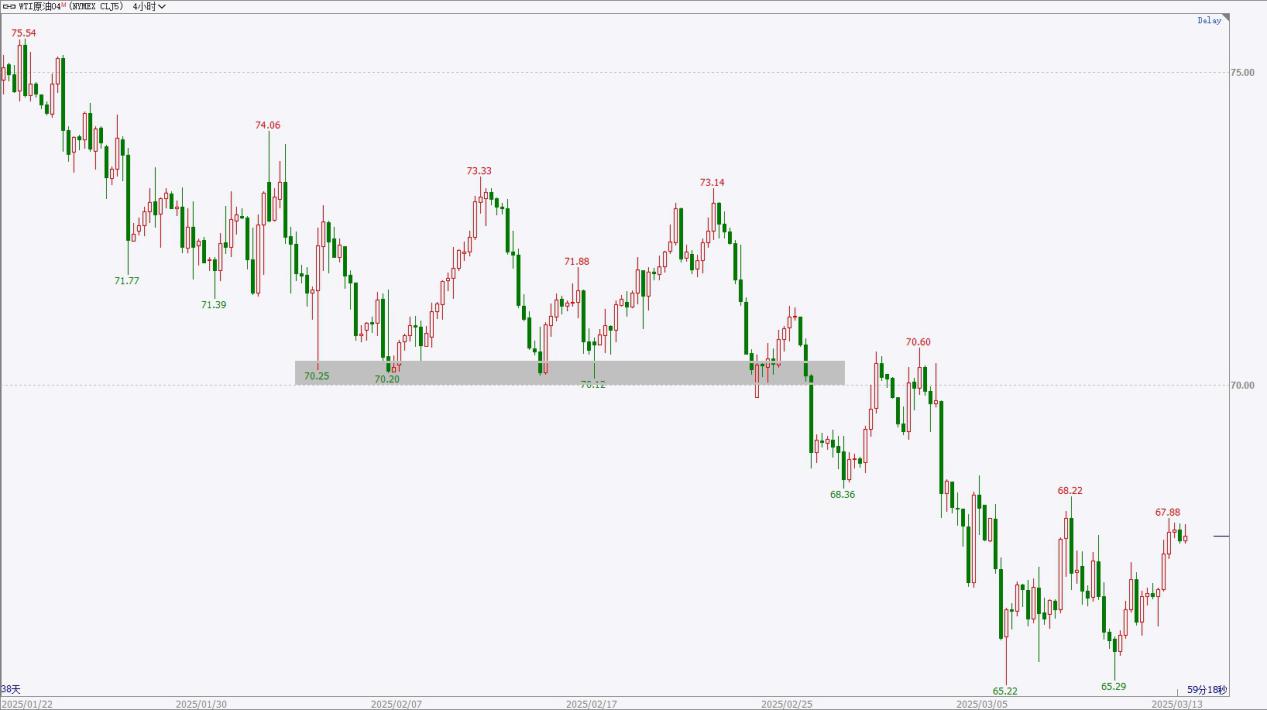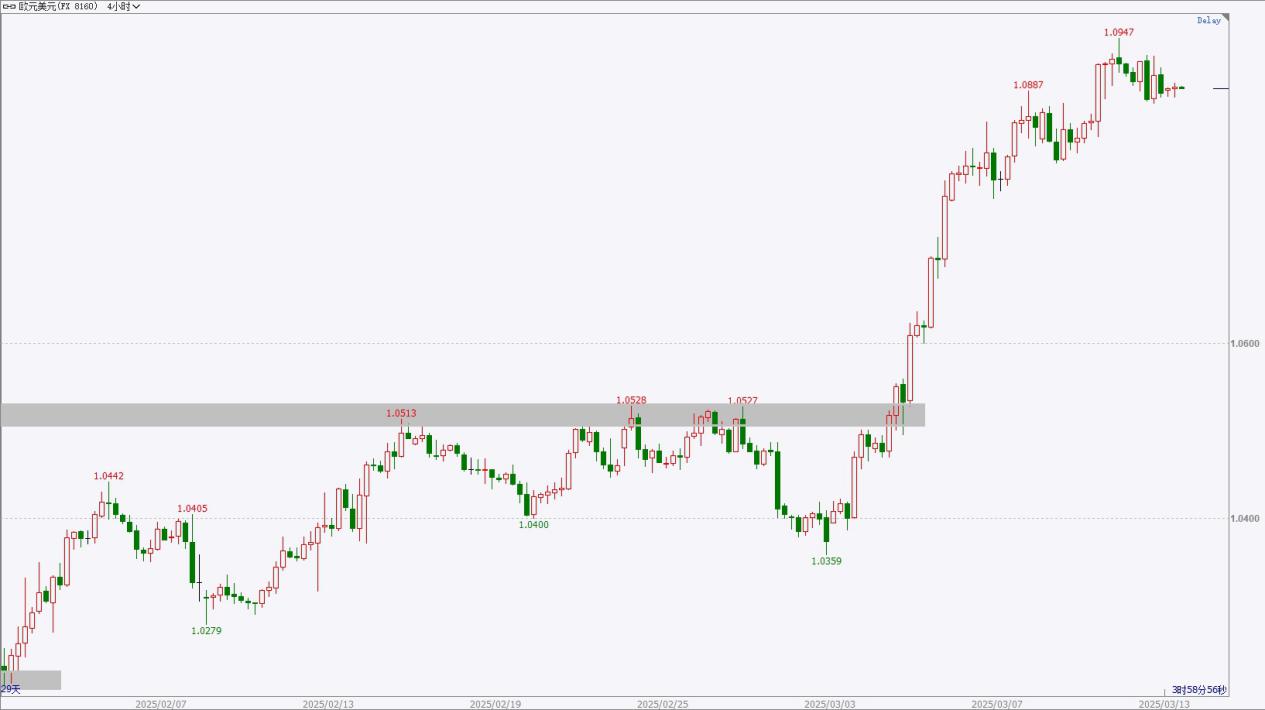|
Time
|
Data and Events
|
Importance
|
|
11:10
|
Bank of Japan Governor Kazuo Ueda attends the Diet.
|
★★★
|
|
17:00
|
IEA publishes monthly crude oil market report.
|
★★★
|
|
18:00
|
Eurozone January industrial output month-on-month.
|
★★★
|
|
20:30
|
U.S. Initial Jobless Claims for the week ending March 8.
|
★★★★
|
|
U.S. February PPI year-on-year.
|
★★★
|
|
U.S. February PPI month-on-month.
|
★★★
|
|
22:30
|
U.S. EIA natural gas inventory for the week ending March 7.
|
★★★
|
|
Varieties
|
Opinions
|
Support range
|
Resistance range
|
|
U.S. Dollar Index
|
Slightly weak oscillation
|
101-102
|
106-107
|
|
Gold
|
Slightly strong oscillation
|
2900-2930
|
2980-3000
|
|
Crude oil
|
Slightly weak oscillation
|
65-66
|
70-71
|
|
Euro
|
Slightly strong oscillation
|
1.0750-1.0800
|
1.0950-1.1000
|
*Pre-market opinions are time-sensitive and limited in scope; they are predictive assessments for reference and learning only. They do not constitute investment advice, and the risk of operations is borne by the individual. Investment involves risks; trading requires caution.
Fundamental analysis:
At the end of January, the Federal Reserve meeting maintained interest rates, the labor market remained strong, economic activity expanded steadily, and inflation levels were still slightly elevated. Expectations for easing monetary policy have cooled, and attention will shift to new government policies. In February, the non-farm payrolls data recorded a job increase of 151,000, slightly below expectations, with the unemployment rate rising slightly to 4.1%. The non-seasonally adjusted CPI year-on-year for February recorded 2.8%, slightly lower than previous values and expectations. The January core PCE price index year-on-year slightly fell, aligning with expectations.
Technical analysis:

The U.S. Dollar Index rebounded slightly yesterday, exhibiting a volatile small-cycle trend; no stabilization signs have appeared yet, maintaining a slightly weak oscillation perspective in the short term. However, caution is warranted for small-cycle rebounds, and if short positions arise, they should be reduced at lower levels to secure profits. Overall, there are signs of a weakening trend following high-level oscillations on the daily chart, with short-term weakness possibly continuing to adjust. The upper resistance area is around 107-107.5, and the lower support area is around 103.5-104.
Opinion: Slightly weak oscillation; the decline in the small cycle is slowing; if short positions arise, reduce them at lower levels to secure profits.
*Pre-market opinions are time-sensitive and limited in scope; they are predictive assessments for reference and learning only. They do not constitute investment advice, and the risk of operations is borne by the individual. Investment involves risks; trading requires caution.
Fundamental analysis:
Ongoing deterioration of conflicts in the Middle East, and easing situation in Eastern Europe present uncertainties. In early March, the European Central Bank’s interest rate decision led to the fifth consecutive 25 basis point rate cut, with inflation progressing smoothly and economic growth risks leaning downwards. At the end of January, the Federal Reserve’s interest rate decision maintained rates, with economic activities performing well despite inflation levels still being elevated, easing rate cut expectations. U.S. February non-farm data showed slight cooling, with new job numbers marginally below expectations and the unemployment rate slightly increasing to 4.1%; the non-seasonally adjusted CPI year-on-year for February recorded 2.8%, marginally below expectations.
Technical analysis:

Gold prices surged significantly during the overnight session, displaying strong performance in the small cycle, with no signs of weakening yet. In the short term, it may test the pressure near previous highs; if long positions arise, consider reducing them at higher levels and monitor whether prices can break previous highs. From a larger cycle perspective, the ascending structure remains intact, with daily oscillations at high levels indicating potential pullbacks. The upper resistance level may be near 2980-3000, and the lower support level may be near 2900-2930.
Opinion: Slightly strong oscillation; it may test the pressure near previous highs in the short term; monitor whether prices can reach new highs.
*Pre-market opinions are time-sensitive and limited in scope; they are predictive assessments for reference and learning only. They do not constitute investment advice, and the risk of operations is borne by the individual. Investment involves risks; trading requires caution.
Fundamental analysis:
The March EIA monthly report basically maintains the oil price forecast for 2025 and slightly raises the global oil demand growth forecast for 2026; the OPEC monthly report keeps the global oil demand growth forecast for this year and next year unchanged. The February IEA monthly report slightly raises the global oil demand growth forecast for 2025. At the beginning of February, the OPEC+ meeting adhered to the previous oil production agreement, and the committee agreed to gradually increase oil production beginning April 1, in line with previous plans. EIA crude oil inventories have slightly increased, which may put pressure on oil prices, and data changes should be monitored.
Technical analysis:

U.S. crude oil has recently rebounded, oscillating back and forth in a small cycle, with selling pressure emerging from above. The current price is at a relatively low level, and the short-term may continue the oscillating trend, making it unwise to pursue short positions. If there are short positions, it is advisable to reduce and take profits on dips while paying attention to signs of stabilization. Overall, crude oil prices are oscillating at low levels without any signs of stabilization. The pressure zone above is around 70-71, while the support zone below is around 65-66.
Viewpoint: Oscillating with a slight weakness, near the support area; if there are short positions, it is advisable to reduce and take profits on dips.
*Pre-market opinions are time-sensitive and limited in scope; they are predictive assessments for reference and learning only. They do not constitute investment advice, and the risk of operations is borne by the individual. Investment involves risks; trading requires caution.
Fundamental analysis:
In early March, the ECB made a decision to lower interest rates for the fifth consecutive time by 25 basis points. The progress of inflation has been smooth, and the GDP growth forecasts for this year and next have been slightly lowered, with economic growth risks leaning towards the downside, while tariffs may bring negative impacts. At the end of January, the Federal Reserve maintained interest rates, with overall economic performance remaining strong, easing expectations somewhat. U.S. non-farm payroll data for February showed a slight easing, with new job additions slightly below expectations and the unemployment rate rising to 4.1%. The manufacturing PMI in the eurozone remained largely unchanged.
Technical analysis:

The euro price experienced a slight pullback during the night session, showing a small cyclical oscillating structure, with no signs of weakness yet. The current price is near the pressure zone, and caution is warranted regarding the risk of market pullbacks. For long positions, it is advisable to reduce and take profits at highs while maintaining a short-term strategy favoring low buy positions. Overall, the price is at a relatively low level, with a daily oscillating structure that may present signals of larger stabilization. The pressure area above is around 1.0950-1.1000, while the small support area below is around 1.0750-1.0800.
Viewpoint: Oscillating with a slight strength, focusing on short-term long positions and reducing and taking profits at highs.
*Pre-market opinions are time-sensitive and limited in scope; they are predictive assessments for reference and learning only. They do not constitute investment advice, and the risk of operations is borne by the individual. Investment involves risks; trading requires caution.


Daily Reviews
Our award-winning team of analysts provides keen and insightful technical and fundamental analysis to understand daily market news and investment trading opportunities
HTFX Daily Forex Commentary 0313
Time
Data and Events
Importance
11:10
Bank of Japan Governor Kazuo Ueda attends the Diet.
★★★
17:00
IEA publishes monthly crude oil market report.
★★★
18:00
Eurozone January industrial output month-on-month.
★★★
20:30
U.S. Initial Jobless Claims for the week ending March 8.
★★★★
U.S. February PPI year-on-year.
★★★
U.S. February PPI month-on-month.
★★★
22:30
U.S. EIA natural gas inventory for the week ending March 7.
★★★
Varieties
Opinions
Support range
Resistance range
U.S. Dollar Index
Slightly weak oscillation
101-102
106-107
Gold
Slightly strong oscillation
2900-2930
2980-3000
Crude oil
Slightly weak oscillation
65-66
70-71
Euro
Slightly strong oscillation
1.0750-1.0800
1.0950-1.1000
*Pre-market opinions are time-sensitive and limited in scope; they are predictive assessments for reference and learning only. They do not constitute investment advice, and the risk of operations is borne by the individual. Investment involves risks; trading requires caution.
Fundamental analysis:
At the end of January, the Federal Reserve meeting maintained interest rates, the labor market remained strong, economic activity expanded steadily, and inflation levels were still slightly elevated. Expectations for easing monetary policy have cooled, and attention will shift to new government policies. In February, the non-farm payrolls data recorded a job increase of 151,000, slightly below expectations, with the unemployment rate rising slightly to 4.1%. The non-seasonally adjusted CPI year-on-year for February recorded 2.8%, slightly lower than previous values and expectations. The January core PCE price index year-on-year slightly fell, aligning with expectations.
Technical analysis:
The U.S. Dollar Index rebounded slightly yesterday, exhibiting a volatile small-cycle trend; no stabilization signs have appeared yet, maintaining a slightly weak oscillation perspective in the short term. However, caution is warranted for small-cycle rebounds, and if short positions arise, they should be reduced at lower levels to secure profits. Overall, there are signs of a weakening trend following high-level oscillations on the daily chart, with short-term weakness possibly continuing to adjust. The upper resistance area is around 107-107.5, and the lower support area is around 103.5-104.
Opinion: Slightly weak oscillation; the decline in the small cycle is slowing; if short positions arise, reduce them at lower levels to secure profits.
*Pre-market opinions are time-sensitive and limited in scope; they are predictive assessments for reference and learning only. They do not constitute investment advice, and the risk of operations is borne by the individual. Investment involves risks; trading requires caution.
Fundamental analysis:
Ongoing deterioration of conflicts in the Middle East, and easing situation in Eastern Europe present uncertainties. In early March, the European Central Bank’s interest rate decision led to the fifth consecutive 25 basis point rate cut, with inflation progressing smoothly and economic growth risks leaning downwards. At the end of January, the Federal Reserve’s interest rate decision maintained rates, with economic activities performing well despite inflation levels still being elevated, easing rate cut expectations. U.S. February non-farm data showed slight cooling, with new job numbers marginally below expectations and the unemployment rate slightly increasing to 4.1%; the non-seasonally adjusted CPI year-on-year for February recorded 2.8%, marginally below expectations.
Technical analysis:
Gold prices surged significantly during the overnight session, displaying strong performance in the small cycle, with no signs of weakening yet. In the short term, it may test the pressure near previous highs; if long positions arise, consider reducing them at higher levels and monitor whether prices can break previous highs. From a larger cycle perspective, the ascending structure remains intact, with daily oscillations at high levels indicating potential pullbacks. The upper resistance level may be near 2980-3000, and the lower support level may be near 2900-2930.
Opinion: Slightly strong oscillation; it may test the pressure near previous highs in the short term; monitor whether prices can reach new highs.
*Pre-market opinions are time-sensitive and limited in scope; they are predictive assessments for reference and learning only. They do not constitute investment advice, and the risk of operations is borne by the individual. Investment involves risks; trading requires caution.
Fundamental analysis:
The March EIA monthly report basically maintains the oil price forecast for 2025 and slightly raises the global oil demand growth forecast for 2026; the OPEC monthly report keeps the global oil demand growth forecast for this year and next year unchanged. The February IEA monthly report slightly raises the global oil demand growth forecast for 2025. At the beginning of February, the OPEC+ meeting adhered to the previous oil production agreement, and the committee agreed to gradually increase oil production beginning April 1, in line with previous plans. EIA crude oil inventories have slightly increased, which may put pressure on oil prices, and data changes should be monitored.
Technical analysis:
U.S. crude oil has recently rebounded, oscillating back and forth in a small cycle, with selling pressure emerging from above. The current price is at a relatively low level, and the short-term may continue the oscillating trend, making it unwise to pursue short positions. If there are short positions, it is advisable to reduce and take profits on dips while paying attention to signs of stabilization. Overall, crude oil prices are oscillating at low levels without any signs of stabilization. The pressure zone above is around 70-71, while the support zone below is around 65-66.
Viewpoint: Oscillating with a slight weakness, near the support area; if there are short positions, it is advisable to reduce and take profits on dips.
*Pre-market opinions are time-sensitive and limited in scope; they are predictive assessments for reference and learning only. They do not constitute investment advice, and the risk of operations is borne by the individual. Investment involves risks; trading requires caution.
Fundamental analysis:
In early March, the ECB made a decision to lower interest rates for the fifth consecutive time by 25 basis points. The progress of inflation has been smooth, and the GDP growth forecasts for this year and next have been slightly lowered, with economic growth risks leaning towards the downside, while tariffs may bring negative impacts. At the end of January, the Federal Reserve maintained interest rates, with overall economic performance remaining strong, easing expectations somewhat. U.S. non-farm payroll data for February showed a slight easing, with new job additions slightly below expectations and the unemployment rate rising to 4.1%. The manufacturing PMI in the eurozone remained largely unchanged.
Technical analysis:
The euro price experienced a slight pullback during the night session, showing a small cyclical oscillating structure, with no signs of weakness yet. The current price is near the pressure zone, and caution is warranted regarding the risk of market pullbacks. For long positions, it is advisable to reduce and take profits at highs while maintaining a short-term strategy favoring low buy positions. Overall, the price is at a relatively low level, with a daily oscillating structure that may present signals of larger stabilization. The pressure area above is around 1.0950-1.1000, while the small support area below is around 1.0750-1.0800.
Viewpoint: Oscillating with a slight strength, focusing on short-term long positions and reducing and taking profits at highs.
*Pre-market opinions are time-sensitive and limited in scope; they are predictive assessments for reference and learning only. They do not constitute investment advice, and the risk of operations is borne by the individual. Investment involves risks; trading requires caution.
Latest Reviews
HTFX Daily Forex Commentary 0819
HTFX Daily Forex Commentary 0815
HTFX Daily Forex Commentary 0812
HTFX Daily Forex Commentary 0811
Choose a Trusted Broker for Trading
Over 300 employees worldwide, more than 1,000 products, top-tier liquidity